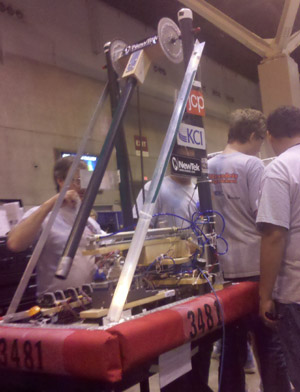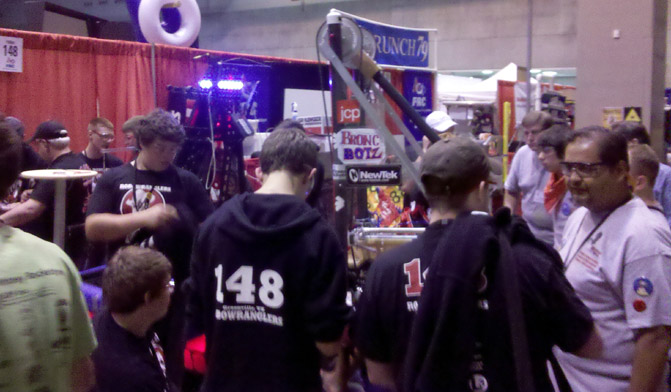FRC 2011
FIRST is an organization that challenges kids and mentors to build robots for competition in unique games. Each year there is a new ‘season’ and in each season the rules and goals of the game are different. There are several leagues which are each progressively more challenging and complex. The beginning leagues are typically for younger children and challenge them to make robots using Legos while the more senior leagues are aimed at junior high and high school aged kids and the robots and challenges are much more complex and open ended.
The teams I mentor (realistically, we are all one team just with different sub-groups) are all at Brandeis high school (the Bronc Botz ) and they compete in two leagues:
FTC – We have 2 teams that play in the FIRST Tech Challenge (FTC) league. The games in the league are played on 12’ x 12’ fields with robots that are about the size of a small microwave oven. The parts they use are from a common kit of parts allowing for a fairly limited amount of external materials. The challenge here is to be creative and effective amongst peers by using a common set of parts. The teams we had this year for this league did not need much help from mentors and they developed their bots alongside the rest of us while we worked on the big bot for the FRC league.
FRC – At Brandeis, we currently have 1 team in the FIRST Robotics Competition (FRC) league. This is the original competition that began with FIRST 20 years ago this year and is considered ‘the big leagues’. Each year the game format and field changes, but the 2011 season has been played with robots that were as tall as 5 feet high and as heavy as 160 pounds. The field was a 27’ x 54’ carpeted arena where we were challenged to do a number of things to score points in a game. For instance, this year we could score points by placing inflated inner tubes on pegs in a wall that went as high as 9’, placing inner tubes on the same pegs under an autonomous mode, and deploying a mini bot to quickly climb a 10’ pole. This league has a designated kit of parts each year, but many more external parts and materials are allowed – we see some really awesome designs, very polished strategies, and professional-quality equipment.
Typically, us mentors get the students organized and working and we try to let them do as much as possible. There are times when the mentors do a lot of the work, especially in the case of using dangerous equipment or in a team’s first couple of years competing, as a team is simply not yet organized nor do they know what to expect.
For FRC, A ‘season’ starts with a world-wide live kickoff announcement where the game rules are revealed and the new kit of parts is handed-out (next season’s kickoff is on Saturday, January 7th, 2012). After that, we’ll have 6 weeks to build a bot after which we crate-up the bot and send it to the regional event where we’ll first compete. In our first FRC season, which has just ended, we competed in only the Alamo regionals, but next year we plan on playing in that one as well as Dallas and possibly a third like Houston. A team can compete in as many regional events as they have money for – even if they’ve already qualified to go to the world championships. The regional events each qualify several teams to go the world championships, which should be in St. Louis again next year. And there are about 6 weekends of regionals, so some teams can go to multiple ones each year.
In the off-season, which just started this week for us, we will still be busy tweaking last year’s robot and competing in a couple Texas events which mirror last year’s rules and so forth over the summer. Right after the beginning of the school year we will take inventory of the program and students and get our game plan updated.
This last year we had no troubles with funding – we just needed more mentors and experience. Funding is already lined up for next year and we’ve now got a lot more experience, as well as the friends we’ve made with former world championship teams, but we can use more mentors. We should have quite a few more students involved in the program this coming year as our making the world championships , and then almost making the finals, got a lot of attention from other students, schools, the press, and the Texas board of educators. At the world championships last weekend, we ended the event with a record of 7 wins and 3 loses which is unheard of for a rookie team – this record was much better than any other San Antonio team has ever done, and San Antonio has only sent a team to the world championships a couple times in 20 years.
We have a lot of fun learning alongside the students and they are an amazing bunch – there were only a few seniors that will not be returning for the next season, so we have a great opportunity to keep the ball rolling. This last year we had 4 mentors who were dedicated and technically-oriented which help design and build robots, while we had a few others that took care of all the other stuff like fund raising, media, and so forth. All of those are coming back and some of our key people will be even more involved next year.
Click here to see various video media for this season
Reflection of FRC championship in St. Louis
I want to share some thoughts about the whole FRC experience. 781 lost communication in autonomous twice... 177 should have picked us! Grrrr also when we lost our last game we could have won if we would have defended against minibot deployment. We would have most-likely have picked 177. We played solid defense except for the first game we lost where we focused on getting tubes moved; however, we lost an alliance robot as well, and as JVN puts it, we didn't win an unbeatable match.
This trip was so much larger than regionals, with 4 divisions, and 4 different match fields. The overall experience was however more pleasant where there really wasn't anyone complaining about if we exceeded our pit boundaries. Also most the alliance partners had very good talks with us filled with information on each team. They had scouts provide all kinds of data. My favorite team had a white board and drew out our positions. The only thing that was slightly annoying is how the inspections here get a bit more superfluous about the outer appearance of the robot. I suppose at championship level they want the sponcers and team name shown in case they win... they want it to look good for the media. We did have one judge (not during inspection) comment on how the chain retention could have been better if it had a groove out of it. He also recommended we protect the cRIO and other motor controls with the plexy glass that we started to apply.
Our robot went through quite a transformation... we applied plexy glass on the sides for sponcer decals and our name. My favorite change was the red and green tape to help determine the orientation of the robot. We also posted arrows on the sides. I believe these helped because Jonas no longer needed to test his direction as he did in regionals. The main functional change involved welding of the wheels with the machine shop service.
It is so cool to hear ideas from other teams... in our last match (which was a great way to end) The 33 killer bee team gave me some details on how to use the gyro sensor to help the robot go straight as well as do turns. A good test of this would be 90 degree turns and a long straight line where students would kick the robot off course and it would make the corrections. This sounds like something I should try.
During the last day we pursued autonomous with the arm. It actually started to work with some oscillation, and then I hit the zero setting and it flew all the way backwards and thwack!!! The chain fell out of alignment. That pretty much ended our attempts, and I regret that I did not have someone hit the stop button in time. I can tell you that I've started working with physics code since back in 2007, and I cannot count the number of times that it was unstable due to bugs. Over the years of testing I'd like to think I got them all... at least the consequences of the bugs back then were ships that did some funny dancing and shaking around on the monitor, but now the steaks are higher... and it is a bit scary that we deal with real moving parts. This keeps me on edge, so I'll need to really sit down with the code and make sure I know exactly why the error occurred!

In closing I want to take a moment to personally thank Team 148 the RoboWranglers for helping us so much that I'd dare recommend changing our team name to RoboWrangler-South! (We have the 148 in our Team Number 3481 too). I'll be the first to admit how lost we were both in getting started with the robot, and setting up the wind-river build deploy environment. They helped get us on track, with an awesome traction frame which is ideal for defense, and they explained to me a bit about getting the ideal torque to weight ratio (this is something I want to further understand for next season). For the programming side they helped us figure out how to build and deploy (I cannot begin to tell you how many road blocks we had for this). During the regional competition they helped us fix an autonomous bug which caused the robot to fail working during teleop, and helped point me in the right direction for the use-case for PID (more on this later). They helped point me to a solution to choose what kind of autonomous mode to use, and this feature could have saved team 781 as they should have picked "auton 3" or where autonomous mode is in bypass. In the pits during both competitions they helped us keep the robot to drive reliably. I think of all the help, the most I enjoyed was the scrimmage matches at their place which I believe was a mutual benefit to both of our teams. This is something I wish to continue next season, and to be sure and have our robot ready in time before regionals.
